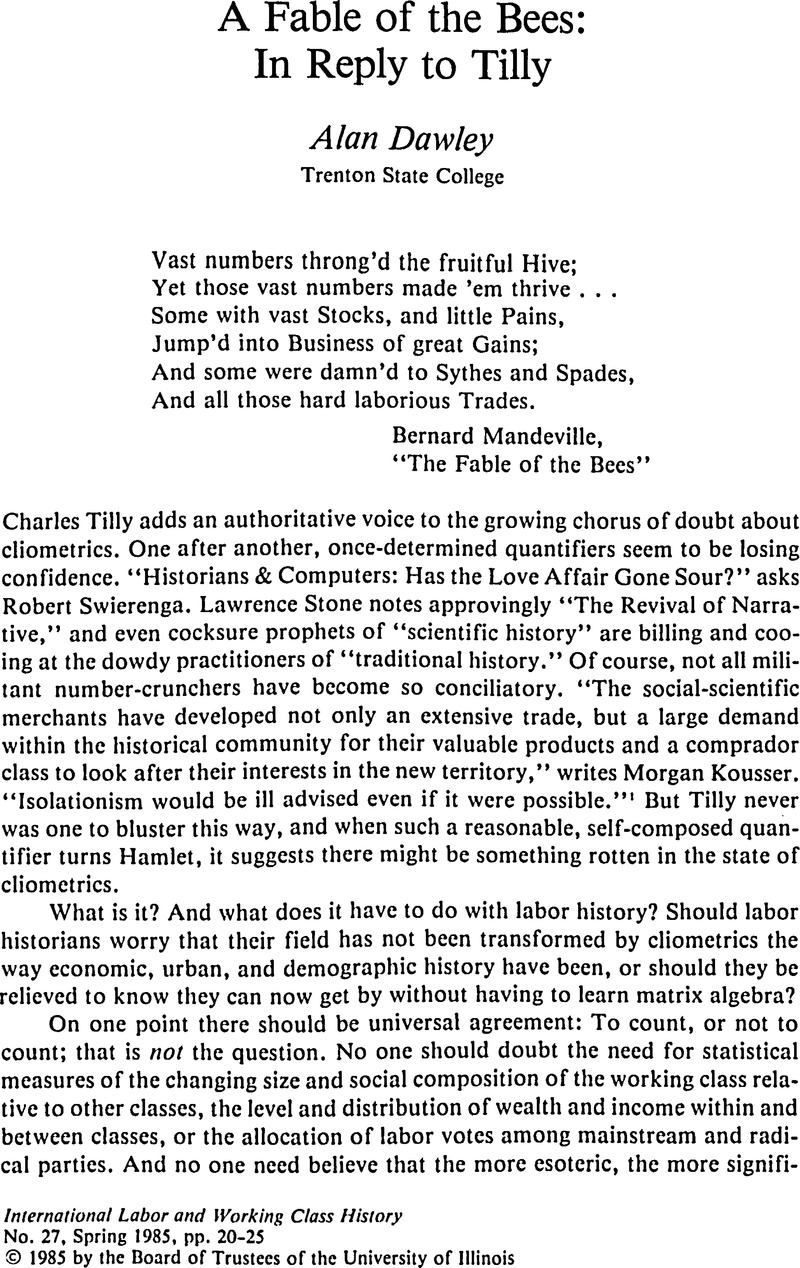No CrossRef data available.
Article contents
A Fable of the Bees: In Reply to Tilly
Published online by Cambridge University Press: 16 October 2009
Abstract

- Type
- Scholarly Controversies
- Information
- Copyright
- Copyright © International Labor and Working-Class History, Inc. 1985
References
NOTES
1. Swierenga, Robert, “Historians & Computers: Has the Love Affair Gone Sour?” OAH Newsletter (11 1984)Google Scholar; Stone, Lawrence, “The Revival of Narrative: Reflections on a New Old History,” Past and Present 85 (11 1979): 3–24CrossRefGoogle Scholar; Fogel, R. W. and Elton, G. R., Which Road to the Past? Two Views of History (New Haven, 1983)Google Scholar; Kousser, J. Morgan, “Quantitative Social Scientific History,” in The Past Before Us, ed. Kammen, Michael, (Ithaca, 1980), 456.Google Scholar
2. Shergold, Peter, Working-Class Life: The “American Standard” in Comparative Perspective, 1899–1913 (Pittsburgh, 1982)Google Scholar; Edwards, P. K., “The Exceptionalism of the American La bour Movement: The Neglected Role of Workplace Struggle.” (1983).Google Scholar
3. Dublin, Thomas, Women at Work (New York, 1979)Google Scholar; Tilly, Charles, Tilly, Louise, and Tilly, Richard, The Rebellious Century 1830–1930 (Cambridge, Mass., 1975).CrossRefGoogle Scholar
4. Carr, E. H., What Is History? (New York, 1961), 34–35.Google Scholar
5. Zunz, Olivier, The Changing Face of Inequality (Chicago, 1982), 5.Google Scholar
6. Besides Tilly's brief definition in the paper under discussion, see Herlihy, David, “Numerical and Formal Analysis in European History,”Google Scholar and Bogue, Allan, “Numerical and Formal Analysis in United States History,” Journal of Interdisciplinary History 12 (Summer 1981)CrossRefGoogle Scholar. For a balanced assessment of the strengths and limits of formal analysis, see McClelland, Peter D., Causal Explanation and Model Building in History, Economics, and the New Economic History (Ithaca, 1975)Google Scholar. McClelland gives formal analysis the inflection of behaviorist psychology, suggesting that causal explanation comes down to a stimulus/response pattern: “similar stimuli, experienced by people with similar dispositions, will result in similar actions” (86), or at least they probably will. For a quasi-Hegelian discussion of causation, see Elster, Jon, Logic and Society: Contradictions and Possible Worlds (Chichester, 1978)Google Scholar; for a pragmatist view, see White, Morton, Foundations of Historical Knowledge (New York, 1965).Google Scholar
7. See Strout, Cushing, The Pragmatic Revolt in American History (Ithaca, 1958)Google Scholar; White, Morton, Social Thought in America: The Revolt Against Formalism (Boston, 1947)Google Scholar; Jones, Gareth Stedman, “From Historical Sociology to Theoretical History,” British Journal of Sociology 27 (09 1976): 295–305.CrossRefGoogle Scholar
8. Thompson, E. P., “The Poverty of Theory,” and “An Open Letter to Leszek Kolakowski,” in The Poverty of Theory and Other Essays (New York, 1978), 84–86, 330–31Google Scholar; Williams, Raymond, Marxism and Literature (Oxford, 1977).Google Scholar
9. Marx, Karl, The 18th Brumaire of Louis Bonaparte (New York, 1963), 15.Google Scholar
10. See the papers prepared for the Northern Illinois Conference on Labor History by Jo Buhle, Mari, “Gender and Labor History,”Google Scholar and Dawley, Alan, “Labor, Capital, and the State in the Twentieth Century”Google Scholar (Dekalb: Northern Illinois University Press, in press).
11. Gordon, David et al. , Segmented Work, Divided Workers (Cambridge, England: 1982).Google Scholar




